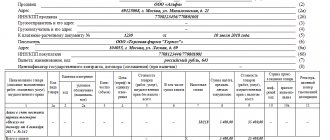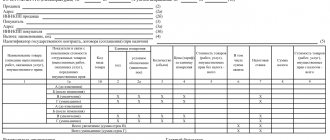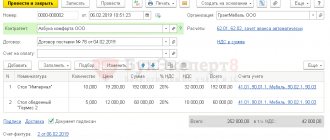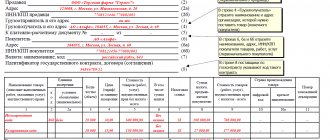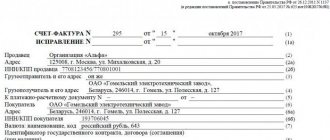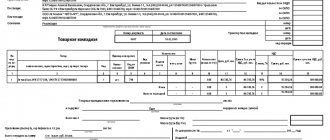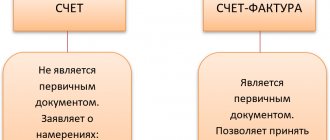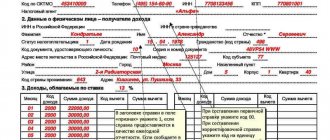An invoice is an accounting document certifying the fact of shipment of goods or provision of services and their cost. It is necessary to confirm the amount of VAT both on the sale of products (services), and to confirm the fact of purchase and incoming VAT. Based on the invoice data, Purchase and Sales Books are formed to account for VAT with the tax authority.
An invoice is issued (sent along with the goods or by mail) by the seller to the buyer (customer) after receiving the goods or services. The invoice has a strictly defined format, approved by Decree of the Government of the Russian Federation dated December 26, 2011 No. 1137.
What is an invoice, why is it needed and who does it belong to - sample
This is a document that is kept by accountants. It confirms that the goods were actually shipped to the buyer or services were provided, and the cost of the products is also stated there.
This paper is sent to the buying party simultaneously with the shipment sent for sale or by mail. Another option is to bill after the products or services have been accepted.
It is important to respect the format in which the invoice will be created and offered. It was approved by a government decree, so you cannot swap fields or create your own spellings, even if they are enshrined in the charter and order of the director of the enterprise.
Who makes up
An invoice is issued by the seller (contractor, performer) to the buyer or customer. Drawing up this form is mandatory for business entities engaged in the sale of goods, performance of work or provision of services.
Why an invoice is needed has already been said (let us repeat briefly: it confirms the issuance and payment of VAT), accordingly, you need to fill out such a form:
- individual entrepreneurs and enterprises subject to the general taxation system (unless their services fall under the exceptions established by clause 2 of Article 149 of the Tax Code of the Russian Federation);
- Individual entrepreneurs and companies that partially work on OSN (for relevant types of activities), also combining it with UTII.
Taxpayers who have chosen UTII, the simplified tax system, or the patent system as their taxation system are exempt from paying VAT, with the exception of certain cases.
Why do you need an invoice if companies and individual entrepreneurs do not have to pay VAT? This may be required if there is commercial interaction with organizations and individual entrepreneurs that are VAT payers. In addition, the parties may decide to apply the invoice on their own initiative.
Types of invoices found in accounting
There are only two of them. The first is called the standard SF. It is created when a shipment has been shipped or work has been completed for which the buyer now owes money. It is necessary when the products are fully paid for. Time for preparation and sending is 5 calendar days from the date of transfer. The same is given if the products were returned back to the supplier.
The second type is advance payment. It should be prepared if prepayment is required or has been credited to the account for future shipments. Here you do not need to fill out fields such as:
- shipper;
- cargo receiver;
- volume of goods or services received;
- units in which everything will be measured.
But be sure to include everything that will be needed later for calculations.
VAT
When the transaction is paid, the seller charges value added tax. SF will be considered as confirmation of the transaction for payment for products; this is recorded in a specialized book. Based on the received invoice, the relevant data in the declaration will be filled in.
If there are no errors in all the papers and everything is done correctly, then the buyer has the opportunity to request a tax deduction under this article.
There are situations when VAT will not be charged. For example, entrepreneurs who work under the simplified tax system do without this. But quite often, without looking at these circumstances, the buying party asks to be given an invoice, even if VAT is not included in it.
Of course, this is not an obligation that the seller must fulfill. But usually they meet halfway and draw up a SF. The only peculiarity is that the document immediately states that the purchase was without value added tax. Accordingly, this line in the form will remain blank.
An important nuance - if the selling party is not a VAT payer, then it cannot enter 0% in this field. This is a separate category of enterprises to which defaulters do not belong. Even 0% is a realistic rate that these firms are not entitled to. If you need to enter something, it is better to indicate “Without VAT”. This will be true and will not invalidate the document, unlike 0%.
If you enter inappropriate data, then this will become a problem for the recipient of the paper. Inspection authorities issue a fine or charge the standard 18-20%.
Do you want to implement “Store 15”? Get all the necessary information from a specialist.
Thank you!
Thank you, your application has been accepted.
What details can’t you do without?
All conditions were specified in Article 169 of the Tax Code. In order for the SF to be accepted for registration and studied, it must contain certain lines:
- The day on which the document was drawn up, and the serial number upon creation. The number is the one on which the transaction took place. Any numbering that the seller likes. The main thing is that the numbers should go in ascending order and remain consistent. But if the company violated the system and after 55 and 56 issued SF No. 22, then this will not affect the tax deduction in any way.
- The name of the selling organization, full address and all important identification numbers. Everything must be correct, without corrections or errors, easy to read and in a normal font. The abbreviated or full form must be made in such a way that it corresponds to the constituent documents and is consistent with the charter of the company. You can't do without a postal code.
- Everything is spelled out similarly on the buying side. You must correctly indicate where the client is located and where the shipment will be shipped. These lines may be of interest to the tax service.
- Recipient and sender of the cargo, their addresses. This information is necessary when selling products. When work is being performed or a service is being provided, such a line is not needed. When selling goods, you do not have to fill out this field completely. But if you write all the details, then it won’t be an error. The recipient must be described completely in accordance with the statutory documents. In this case, it does not depend on whether the buyer is the consignee or not.
- The name of the products sold, the units in which they are measured. You cannot make mistakes in these fields. It is important to write correctly whether products are counted in pieces, kilograms or liters.
- The number of products that were sold or the volume of services provided. This line indicates how many parts or watermelons were eventually sold to this buyer. The calculation and the total amount depend on this part.
- Price or tariff. Counts as a unit of measurement, if possible. Indicated without VAT or including it, depending on what is specified in the contract.
- Paper currency. How everything is calculated and payment will be made. A code is written that is listed in the All-Russian Classifier. It can be a ruble (643), a dollar (840), euro (978) or any other official currency.
- The total cost of products sold. Be sure to carefully calculate and indicate. Errors and adjustments are not allowed. More often, a document is prepared electronically, and all fields are filled in automatically, so the risk of making a mistake tends to zero.
- Tax rate. It could be 0%, 10% or 20% depending on how the company operates and what it sells. If the company is on a simplified basis or has been completely exempted from calculating and paying value added tax for any reason, then “Without VAT” is written in this line. We have already discussed above how this works and why it is recommended to write correctly.
- The amount of tax calculated. As a rule, programs calculate it automatically; accountants can calculate it manually.
- The full cost for the volume of products or services sold, including tax.
- The country in which everything was produced and the number from the customs declaration. This line is only relevant for goods that were sent from abroad.
You can simplify and optimize business processes using special software. On the Cleverens website you will find solutions suitable for various purposes and tasks.
Description
An invoice is used by accounting to confirm the receipt or shipment of products (services). It indicates the transaction price. The document confirms the accrual of VAT on products (services) provided to the buyer and the fact that the tax has been paid. The main purpose of the document is that it should close a transaction between counterparties, confirming the fact of shipment of products and the accrual of VAT. To apply for an individual entrepreneur deduction, you must take into account the payment of VAT. For this purpose, Purchase and Sales Books are created based on invoices.
Sample sales book
An invoice is an official document generated by the supplier of products (services) for the buyer after their acceptance. The primary document is sent by post or can be sent directly with the goods. The form of the document is determined at the legislative level. The requirements for the document can be found in Decree of the Government of the Russian Federation No. 1137 of December 26, 2011.
Business entities need to constantly monitor changes in legislative acts, as adjustments are periodically made to the form. Only a current document has legal significance.
The latest adjustments to the document were made in 2021 by Government Decree No. 981 dated August 19, 2017. In accordance with it, the invoice form and the methodology for its preparation were changed:
- the identification number of the government contract is indicated in the invoice, if available;
- a column “Product type code” has appeared, which is filled in in case of export of products to the EAEU countries;
- Previously, column 11 indicated the number of the customs declaration, currently - the registration number of the customs declaration;
- a person authorized by the business entity has the right to sign the invoice;
- adjustments have been made to the methodology for filling out line 2A with the supplier’s address data;
- For forwarders, developers and customers acting on their own behalf, additions have been developed to the procedure for filling out the document.
What should the invoice look like? Below is a sample of the new document.
Sample invoice
Another change was the increase in the VAT rate from 18 to 20% from the beginning of 2021. Column 7 indicates the number 20 instead of 18. No other adjustments occurred in connection with the increase in the rate, since the designation of its value is not fixed in the legally established form.
Why do we need paper such as an invoice in the purchasing department and in the accounting department?
First of all, it will be needed to confirm the output VAT when services and products are sold. And later it will be useful to write off the input value added tax at the time of purchase. It will serve as proof of the transaction that took place.
When an outgoing SF is registered, it is entered into the Sales Book. When incoming - from the seller - then in the Purchase Book. As a result, the data in the declaration will be filled out based on the information that is generated in these documents.
If an advance payment is transferred, and the product arrives to the buyer later than 5 days, then an advance SF should be issued. It will confirm the fact of the transaction and will prove to the buying party that they purchased the product or service. If errors are later identified in it, then an additional, corrective SF can be written out.
For an accountant, these are papers that help keep records, confirm current business transactions and are an opportunity to receive a deduction.
Regulatory framework for primary documents
To reflect any business transaction in accounting, it is necessary to have a correctly executed primary document, as stated in paragraph 1 of Art. 9 of the Law “On Accounting” dated December 6, 2011 No. 402-FZ. Next we read in paragraph 4 of Art. 9 of this law, that the forms of primary documents must be developed and approved by the organization. Thus, the use of unified forms of primary documents is optional, with the exception of certain cases. The only obligatory condition is the presence of certain details in the document. On the other hand, there is no ban on the use of unified forms of documents, so the head of the organization must independently determine which forms of primary documents should be used
Procedure for filling out an invoice
We discussed above which fields need to be filled out. Now let's go through the lines:
- (1). There will be a date and number here.
- (2), (2a), (2b), (6), (6a), (6b). Name, addresses, tax identification number and checkpoint of the buying and selling parties. Everything is in accordance with the constituent papers and charter, even if it is written in an abbreviated form.
- (3), (4). The name and postal address that are indicated for the recipient and sender of the cargo. For the SF, which is prepared on the basis of works or services, a dash is placed in this field.
- (5). The date and number that was assigned to the payment document if an advance was given. When it was not issued or was not monetary, a dash is indicated.
- (7). What is the name of the currency and its code. Even if a company has always operated exclusively in rubles, this is written anew in each Federation Council. There should be no ambiguity or other options.
- Table with graphs. In column 1 the name of the products currently being sold and as it was written in the contract or invoice.
- Column 2, 2a, 3, 4. Code and designation of what the product is measured in, volume, cost excluding VAT.
- Column 6. The amount of excise tax or the phrase “without excise tax” depending on the type of product.
- 7, 8. The size of the tax rate and how much it amounted to in rubles and kopecks is not rounded to whole numbers.
- 5, 9. Total cost of everything sold. In the first case, without VAT, and in the second - already taking into account the accrued tax. It is registered twice even if the company operates without VAT.
- 10, 10a, 11. It is necessary to fill out only if the company sells or resells imported goods.
At the end, the head of the organization or his authorized person must sign - usually an accountant. Below is a seal that certifies the correctness of all filled fields.
Agreement
The contract describes the rights and obligations of the parties to the transaction. Typically it contains the following sections:
- Subject of the contract: what will happen as a result of the transaction (for example, sale of goods, provision of services, performance of work);
- Contract amount and payment procedure: when and how much to pay.
- Rights and obligations of the parties: what actions the parties to the contract can (or should) take.
- Responsibility of the parties: what will happen if the individual entrepreneur or the client violates the terms or other terms of the contract.
- The procedure for changing and terminating a contract: how to terminate a contract or accept additional agreements to it.
- Details of the parties: current accounts, INN, OGRN and addresses of the entrepreneur and his counterparty are indicated.
The agreement is usually drawn up in two copies and signed by each party.
If you use a standard contract form to work with clients, replacing the necessary details in Word or Excel, use the templates from Kontur.Elbe. Upload your agreement template, and the program will automatically fill in the details of the counterparty from the directory.
For some transactions, a written contract is not necessary at all. For example, a retail sales contract is considered concluded from the moment the buyer is issued a cash receipt, sales receipt or other document that confirms the fact of payment.
Log books and books
These are mandatory attributes of the functioning of any organization. Each taxpayer is required to draw up a tax return and maintain this documentation when transactions are eligible for taxation.
This is how VAT is calculated in cases of sales of products, provision of services or transfer of property rights. The selling party must register the issued paper in a special sales book. And the buyer will make a similar entry in her own, this time about purchases. This way she will confirm her right to receive a deduction. Then all these amounts will be taken into account in the declarations.
All about the invoice for the seller sender
The obligation to draw up and send the SF to the client is specified in the Tax Code. This is valid for all transactions that are subject to tax accounting. They should be drawn up in a special form, which is approved by the government of the Russian Federation. This form can be found in many programs that help keep track of business transactions. They are compiled in paper and electronic form.
Do you want to implement Warehouse 15? Get all the necessary information from a specialist.
Thank you!
Thank you, your application has been accepted!
Results
The list of mandatory invoice details is provided in paragraphs. 5, 5.1, 5.2 art. 169 of the Tax Code of the Russian Federation, however, in some cases they may not be filled out. Currently, the invoice forms as amended as of 10/01/2017 are in effect, which you can download from our website.
Sources:
- Tax Code of the Russian Federation
- Decree of the Government of the Russian Federation dated May 25, 2017 No. 625
You can find more complete information on the topic in ConsultantPlus. Free trial access to the system for 2 days.
SF functionality
It remains to fully understand what the issued invoice confirms and what function it performs.
The main task of this documentation is to record that the transaction took place and the money was transferred or promised. It is recorded in the books and later becomes a reason for receiving a deduction.
Certificate of provision of services or work performed
This document confirms that the services have been provided or the work has been completed, and the customer has no complaints about their quality. The act is signed by both the contractor and the customer.
In “Kontur.Elbe” the act is drawn up very simply. It is enough to select a counterparty, indicate the service and price. Then you need to send the counterparty a completed document containing your signature and seal.
What can be adjusted
In some cases, it is possible to correct individual fields. But it is important to consider a few rules:
- change only both copies – the one that the seller has and the one that the buyer has;
- all adjustments are endorsed by the head of the selling party and stamped;
- The date when the data was corrected must be written, it can be next to the correction or in the fields nearby.
One more nuance - if you need to change a lot or it is difficult because adjacent lines are filled in, then it is better to draw up the paper again. This will not contradict the law.
We have explained that an invoice for tax purposes is a document confirming that the products were sent from the seller to the recipient or simply sold to him.
Using this paper, you can receive a deduction, as well as create a calculation for filling out a tax return. This is a necessary document, without which a company selling any type of goods or services cannot operate. Number of impressions: 2746
Packing list
This document formalizes the sale of goods to another entrepreneur or organization. This document is not used to work with individuals. The invoice is issued in two copies: the first remains with the supplier and records the shipment of goods, and the second is transferred to the buyer and is needed by him to accept the goods.
Usually the invoice is drawn up according to the standard form No. TORG-12. You can use the invoice template.
In Kontur.Elbe you can create an invoice based on an invoice.
Create an invoice for free in Kontur.Elbe
